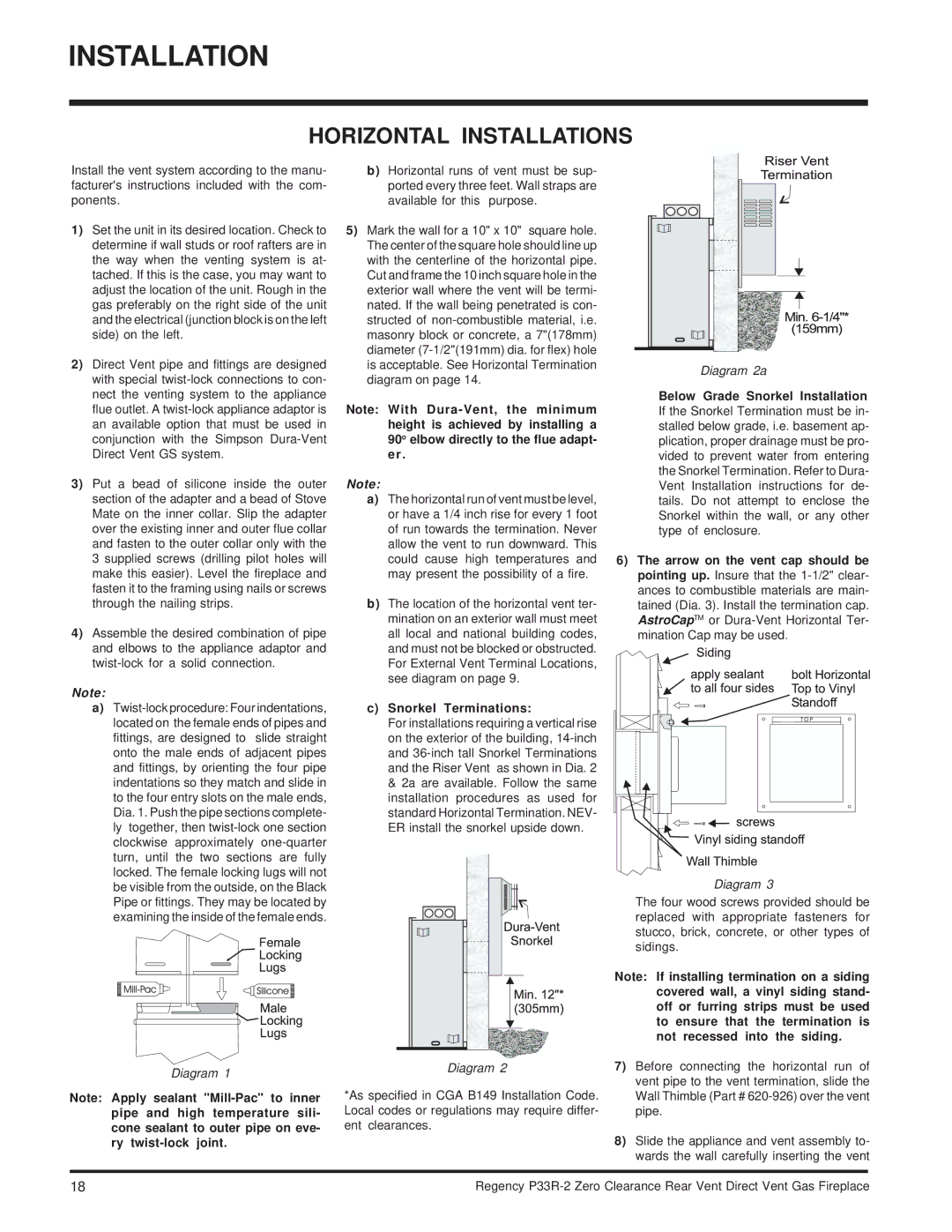
INSTALLATION
HORIZONTAL INSTALLATIONS
Install the vent system according to the manu- facturer's instructions included with the com- ponents.
1)Set the unit in its desired location. Check to determine if wall studs or roof rafters are in the way when the venting system is at- tached. If this is the case, you may want to adjust the location of the unit. Rough in the gas preferably on the right side of the unit and the electrical (junction block is on the left side) on the left.
2)Direct Vent pipe and fittings are designed with special
3)Put a bead of silicone inside the outer section of the adapter and a bead of Stove Mate on the inner collar. Slip the adapter over the existing inner and outer flue collar and fasten to the outer collar only with the 3 supplied screws (drilling pilot holes will make this easier). Level the fireplace and fasten it to the framing using nails or screws through the nailing strips.
4)Assemble the desired combination of pipe and elbows to the appliance adaptor and
Note:
a) |
located on the female ends of pipes and |
fittings, are designed to slide straight |
onto the male ends of adjacent pipes |
and fittings, by orienting the four pipe |
indentations so they match and slide in |
to the four entry slots on the male ends, |
Dia. 1. Push the pipe sections complete- |
ly together, then |
clockwise approximately |
turn, until the two sections are fully |
locked. The female locking lugs will not |
b)Horizontal runs of vent must be sup- ported every three feet. Wall straps are available for this purpose.
5)Mark the wall for a 10" x 10" square hole. The center of the square hole should line up with the centerline of the horizontal pipe. Cut and frame the 10 inch square hole in the exterior wall where the vent will be termi- nated. If the wall being penetrated is con- structed of
Note: With
Note:
a)The horizontal run of vent must be level, or have a 1/4 inch rise for every 1 foot of run towards the termination. Never allow the vent to run downward. This could cause high temperatures and may present the possibility of a fire.
b)The location of the horizontal vent ter- mination on an exterior wall must meet all local and national building codes, and must not be blocked or obstructed. For External Vent Terminal Locations, see diagram on page 9.
c)Snorkel Terminations:
For installations requiring a vertical rise on the exterior of the building,
Diagram 2a
Below Grade Snorkel Installation If the Snorkel Termination must be in- stalled below grade, i.e. basement ap- plication, proper drainage must be pro- vided to prevent water from entering the Snorkel Termination. Refer to Dura- Vent Installation instructions for de- tails. Do not attempt to enclose the Snorkel within the wall, or any other type of enclosure.
6)The arrow on the vent cap should be pointing up. Insure that the
be visible from the outside, on the Black |
Pipe or fittings. They may be located by |
examining the inside of the female ends. |
Diagram 1
Note: Apply sealant
Diagram 2
*As specified in CGA B149 Installation Code. Local codes or regulations may require differ- ent clearances.
Diagram 3
The four wood screws provided should be replaced with appropriate fasteners for stucco, brick, concrete, or other types of sidings.
Note: If installing termination on a siding covered wall, a vinyl siding stand- off or furring strips must be used to ensure that the termination is not recessed into the siding.
7)Before connecting the horizontal run of vent pipe to the vent termination, slide the Wall Thimble (Part #
8)Slide the appliance and vent assembly to- wards the wall carefully inserting the vent
18 | Regency |
